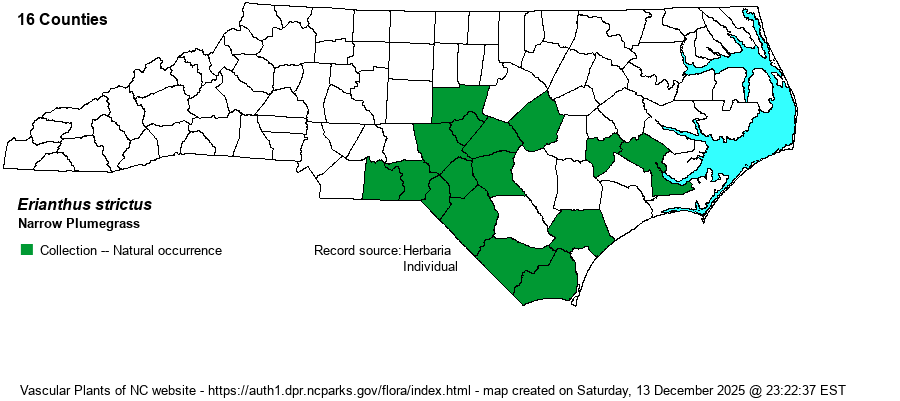| Author | Elliott | |
| Distribution | Southern lower Piedmont, Sandhills, and southern Coastal Plain. Ought to occur in more Coastal Plain counties than the map shows, as it ranges widely in the southeastern part of VA.
Southeastern VA to TN and AR, south to central FL and eastern TX. | |
| Abundance | Frequent in the Sandhills, but uncommon to infrequent elsewhere. Apparently not common anywhere in NC, and individual populations typically consist of small numbers of plants. | |
| Habitat | Blackwater river- and streambanks, backup channels, cypress-gum swamp forests. Piedmont records are from brownwater streams of the Triassic Basin. | |
| Phenology | Flowering and fruiting July-October. | |
| Identification | This is our shortest plumegrass, always less than 6 feet tall, and with a plume that does not expand or broaden in maturity. Thus it looks in the field like an "immature" of other species. Its riverside and streamside habitats should help to ID it. Technically, it can be told by awns that are not coiled into a spiral, and a spikelet beard that is 2 mm long or less. | |
| Taxonomic Comments | A synonym is Saccharum baldwinii.
Plumegrasses are among our tallest grasses; several species reach 7-8 feet tall. The narrowly to broadly elliptical inflorescences stand erect well beyond the long, arching leaves. For proper ID, it is best to use mature spikelets. When immature, the inflorescences are tightly compact and slender; when mature, they relax and become elliptical in outline, and individual spikelets can be seen. Do not confuse these natives with the alien invasive Phragmites australis, which has much broader leaves and whose inflorescence branches are mostly swept to one side. | |
| Other Common Name(s) | None | |
| State Rank | S3S4 | |
| Global Rank | G5 | |
| State Status | | |
| US Status | | |
| USACE-agcp | | |
| USACE-emp | | |

